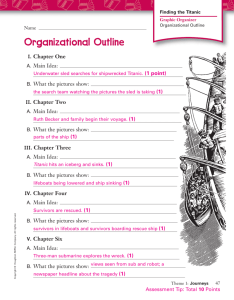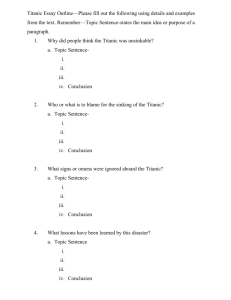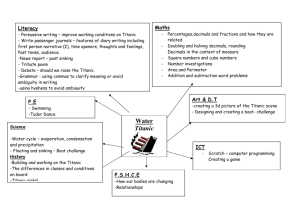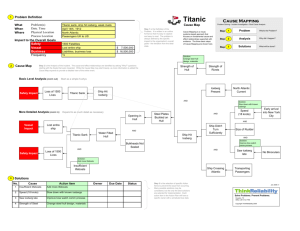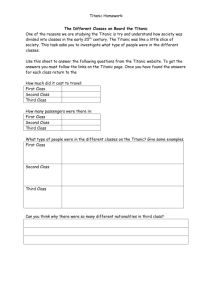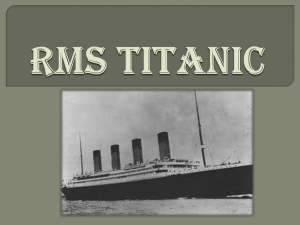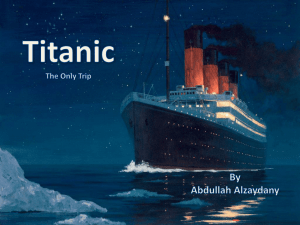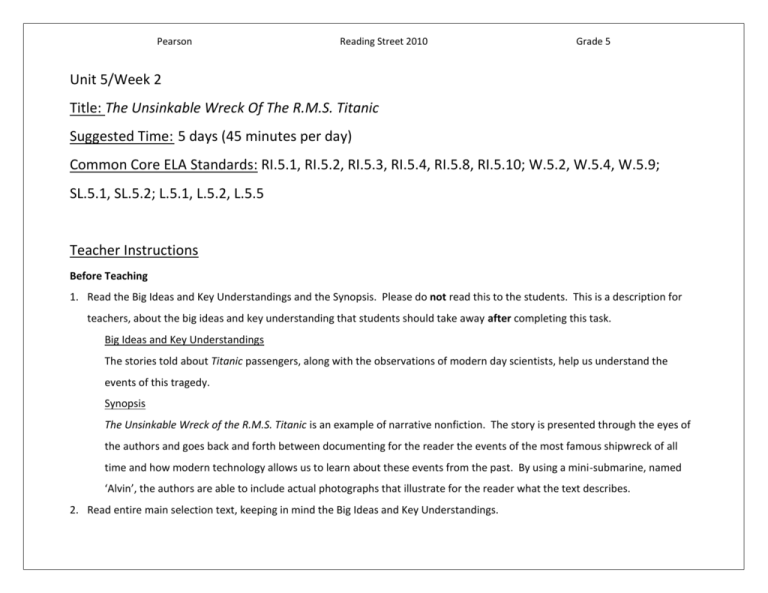
Pearson
Reading Street 2010
Grade 5
Unit 5/Week 2
Title: The Unsinkable Wreck Of The R.M.S. Titanic
Suggested Time: 5 days (45 minutes per day)
Common Core ELA Standards: RI.5.1, RI.5.2, RI.5.3, RI.5.4, RI.5.8, RI.5.10; W.5.2, W.5.4, W.5.9;
SL.5.1, SL.5.2; L.5.1, L.5.2, L.5.5
Teacher Instructions
Before Teaching
1. Read the Big Ideas and Key Understandings and the Synopsis. Please do not read this to the students. This is a description for
teachers, about the big ideas and key understanding that students should take away after completing this task.
Big Ideas and Key Understandings
The stories told about Titanic passengers, along with the observations of modern day scientists, help us understand the
events of this tragedy.
Synopsis
The Unsinkable Wreck of the R.M.S. Titanic is an example of narrative nonfiction. The story is presented through the eyes of
the authors and goes back and forth between documenting for the reader the events of the most famous shipwreck of all
time and how modern technology allows us to learn about these events from the past. By using a mini-submarine, named
‘Alvin’, the authors are able to include actual photographs that illustrate for the reader what the text describes.
2. Read entire main selection text, keeping in mind the Big Ideas and Key Understandings.
Pearson
Reading Street 2010
Grade 5
3. Re-read the main selection text while noting the stopping points for the Text Dependent Questions and teaching Vocabulary.
During Teaching
1. Students read the entire main selection text independently.
2. Teacher reads the main selection text aloud with students following along. (Depending on how complex the text is and the
amount of support needed by students, the teacher may choose to reverse the order of steps 1 and 2.)
3. Students and teacher re-read the text while stopping to respond to and discuss the questions and returning to the text. A variety
of methods can be used to structure the reading and discussion (i.e.: whole class discussion, think-pair-share, independent
written response, group work, etc.)
Text Dependent Questions
Text-dependent Questions
Based on the text, why does the narrator feel as though he had,
“walked into a dream”? (page 547)
Using the timeline, describe what happened to the Titanic.
Evidence-based Answers
The Alvin “rose up the side of the famous bow, now weeping
great tears of rust, past the huge anchor and up over the rail.
We were the first in more than seventy years to “walk” on the
Titanic’s deck! The giant windlasses used for raising and
lowering the anchor still trailed their massive links of chain, as if
ready to lower away.” All of these details support the
narrator’s statement that he feels as though he had just walked
into a dream. He can’t believe it’s happening and that it is
actually real. Many things look as though they are ready to be
used. He was so excited he was almost shouting. After years of
questing, he had arrived at the “resting place” of the “greatest
shipwreck of all time”.
The ship entered an ice field, scraped an iceberg on the
starboard side, and the bow of the ship went underwater. The
Titanic broke in two and sank.
Pearson
Reading Street 2010
The author uses figurative language to help put a mental picture
in the reader’s head. On page 547, the author states that the
Titanic was “weeping great tears of rust.” What image does this
put into the reader’s head? What is the effect of using this
personification?
Reread pages 548-549. Why did so many people die on the
Titanic?
Beginning on page 550, the author moves between present
events on the Alvin and events of the past on the Titanic. When
the narrator paused at the crow’s nest, what events did this
bring to mind?
What words or phrases describe what First Officer William
Murdoch was watching in “excruciating agony”? (page 550)
Doomed means that something is beyond repair or hope. How
did captain E.J. Smith know the Titanic was doomed? (page 550)
What was significant about Minnie and her boys getting on a
lifeboat? (page 553)
Grade 5
“Effortlessly we rose up the side of the famous bow, now
weeping great tears of rust”. This is giving the boat the human
quality of sadness and it is an image that the boat is crying
tears. The fact that rust is red in color can also symbolize
bleeding or death.
An iceberg was seen too late and there were too few lifeboats
for the number of passengers. They didn’t fill the first lifeboats
to capacity. Pandemonium ensued on the ship and the
evacuation was not organized. The boat sank quickly and
eventually broke into 2 pieces. Very few of the third class
passengers survived because they were the last to get on the
lifeboats, if there was any space left.
When the narrator paused at the crow’s nest, it reminded him
that Frederick Fleet was on duty at the crow’s nest and was the
lookout who warned the bridge: “iceberg right ahead.” He
made it to a lifeboat and to safety.
First Officer William Murdoch watched the Titanic slowly turn
“too late as the iceberg fatally grazed the liner’s side”. It is
painful for him to watch because he knows that the boat is not
going to turn in time and will strike the iceberg.
The captain could see how quickly the water was pouring into
the ship and that the “unsinkable” ship would not be able to
survive.
They were some of the only third class passengers to be saved
from the sinking. It was also significant because Willie was
wearing a hat that made him look older than his 11 years and
the lifeboats were for women and children first.
Pearson
Reading Street 2010
The author states, “We saw hundreds of touching reminders of
the tragedy”. Give examples from the text and explain how the
items are considered touching reminders. (page 555)
Grade 5
The narrator sees the ship’s boiler, set upright on the mud with
a tin cup resting on it. Champagne bottles lay with their corks
still intact, a porcelain doll’s head and most haunting of all, he
saw shoes and boots. These are mute reminders of the human
cost of the Titanic tragedy.
Pearson
Reading Street 2010
Grade 5
Vocabulary
STUDENTS FIGURE OUT THE MEANING
TEACHER PROVIDES DEFINITION
sufficient context clues are provided not enough contextual clues provided
in the text
in the text
KEY WORDS ESSENTIAL TO UNDERSTANDING
tragedy (throughout text) – a disastrous occurrence; calamity
doomed (pg 550) – beyond repair or without hope
questing (pg 547) – seeking
plunge (pg 547) – to trust or throw suddenly
excruciating (pg 550) – extremely painful
agony (pg 550) – pain
pandemonium (pg 549) – chaos, a situation where there is a lot
of noise because people are angry, confused, or frightened
contorted (pg 553) – twisted, not in its natural shape, looks
strange
WORDS WORTH KNOWING
materialized (pg 547) – appeared
maiden (pg 548) – first
debris (pg 554) – things left behind after something is destroyed
film (pg 554) – thin layer
sediment (pg 554) – minerals that settle at bottom of liquid
ascent (pg 555) – climb upwards
plumb (pg 555) – to get to the bottom of
effortlessly (pg 547) – result of working or trying
weeping great tears of rust (pg 547)
surging (pg 550) – to move in
mute (pg 551) – quiet, unable to speak
prevailed (pg 553) – to triumph or succeed
Pearson
Reading Street 2010
Grade 5
Culminating Task
Re-Read, Think, Discuss, Write
How does the author support his point that the sinking of the Titanic is a tragedy? In a well-crafted paragraph, provide at least
three specific pieces of evidence, including direct quotations from the text to support your idea.
o Answer: There are many reasons that the sinking of the Titanic is referred to as a tragedy. The author states, “…we saw
hundreds of touching reminders of the tragedy.” (page 555) The photographs on page 555 show evidence of an
expensive doll’s head, and a fancy tin cup. These items once belonged to a child who might have died on the Titanic. On
page 554, the author points out, “most haunting of all were the shoes and boots.” This part explains that there is
evidence that many people died because the shoes are in pairs. The shoes are a way to see how many people lost their
lives in this tragic event. Finally, there is text evidence on page 554 that “champagne bottles lay with their corks still
intact.” It is sad to think that these people were traveling and celebrating and never thinking that the ship was going to
sink and that they might die. The sinking of the Titanic is an example of a tragic event in which many people died and
that this could have possibly been prevented if the captain had just seen the large iceberg earlier.
Additional Tasks
Amelia Earhart disappeared during a flight around the world. Research the technology she was using to complete this flight and
write a report in which you explain theories about how it failed her.
o Amelia Earhart was flying in a twin-engine plane called the Electra. She made it half way through her journey and her
radio communication went out and it is thought that she was unsure of her location. She needed to fuel up on a small
island, but she never landed at her destination. It is thought that she must have ran out of fuel.
Pearson
Reading Street 2010
Grade 5
Research how underwater explorers use sonar. Create a poster on which you use photos or diagrams of a submersible and label
specific features. Write captions that explain how the device helps humans explore the ocean depths.
sonar (sō'när) [key], device used underwater for locating submerged objects and for submarine communication by means of
sound waves. The term sonar is an acronym for sound navigation ranging. The main component of sonar equipment is an
electroacoustic transducer that is in direct contact with the water. It is suspended from the hull of a ship or on a cable from a lowflying helicopter. The transducer converts electric energy into acoustic energy (thus acting as a projector), much as does a
loudspeaker, and converts acoustic energy into electric energy (serving as a hydrophone), as does a microphone. A pulse of electric
energy vibrates the diaphragm of the projector, sending sound waves through the water. These waves are concentrated into a
sound beam, which scans the water when the projector is rotated. After the sound wave is emitted, the projector is converted into a
hydrophone and listens for an echo. The cycle is repeated periodically. A returning echo is converted into an electric current by the
transducer and may be interpreted (for range, bearing, and the nature of the target) aurally or by a cathode-ray tube, as is done with
radar signals. The various types of sonar in use can be put into three classes: direct listening, communications, and echo ranging. In
direct listening, the object under observation generates the sounds that are received. In communications and echo ranging the sonar
must generate its own signals. Sonar operates in the 10- to 50-kilocycle acoustical frequency range. It is used for communication
between submerged submarines or between a submarine and a surface vessel, for locating mines and underwater hazards to
navigation, and also as a fathometer, or depth finder. Sonar is widely used by commercial fishermen for locating shoals of fish.
Research has suggested that sonar used for echo ranging can cause a disorder similar to decompression sickness (in which
nitrogen bubbles form in body tissues) in some beaked whales and dolphins and that this may be linked to strandings of those
species.
See J. W. Horton, Fundamentals of Sonar (1957); D. G. Tucker, Underwater Observation Using Sonar (1966).
o The Columbia Electronic Encyclopedia, 6th ed. Copyright © 2007, Columbia University Press. All rights reserved.
***See attached diagram for sample poster
Many people rely on GPS navigation systems. Research what GPS is, how it works, and when it was created, and write an
informational article in which you break this information into sections.
navigation satellite, artificial satellite designed expressly to aid the navigation of sea and air traffic. Early navigation satellites, from
the Transit series launched in 1960 to the U.S. navy's Navigation Satellite System, relied on the Doppler shift. Based on the shift in
the satellite's frequency, a ship at sea could accurately determine its longitude and latitude. The Global Positioning System (GPS),
which uses a web of 24 Navstar satellites in 12-hour orbits, employs the more accurate triangulation method to determine position.
Each satellite broadcasts time and position messages continuously. Precise to within a few yards, the GPS can also be used for
nonnavigation purposes, such as surveying, tracking migrating animals, and plotting the crop yields of small sections of farmland.
The former Soviet Union established a Navstar-equivalent system known as the Global Orbiting Navigation Satellite System
Pearson
Reading Street 2010
Grade 5
(GLONASS). Russia's GLONASS will use the same number of satellites and orbits similar to those of Navstar when complete.
See T. Logsdon, Understanding the Navstar: GPS, GIS, and IVHS (1995); B. Hofmann-Wellenhoff, Global Positioning System:
Theory and Practice (1997).
o The Columbia Electronic Encyclopedia, 6th ed. Copyright © 2007, Columbia University Press. All rights reserved.
Possible titles for additional reading about technology and adventurers:
o To the Top: The Story of Everest by Stephen Venables
o Dive to the Deep Ocean: Voyages of Exploration and Discovery by Deborah Kovacs
o The International Space Station: A Journey into Space by Wolfgang Engelhardt
There are several ways how the sinking of the Titanic is recounted. Discuss the various accounts of this tragedy. Discuss how
these different points of view provide details about this event.
Possible answers:
The timeline shows the events by the day and the hour. The narrative details the events of the night. The present evidence
explored by the Alvin shows the aftermath. The photographs show the destruction and the wreckage. The sidebar articles gives the
story a human voice.
Using the text, create a sequence of events describing Alvin’s journey through the wreckage of the Titanic.
1st: pg. 547 explored the bow, observed the anchor and “walked” the deck
2nd: pg. 550 explored the well deck, foremast, the bridge
3rd: pg. 550 explored the stern, 1st class entrance
4th: pg. 554 explored the debris field
5th: pg. 555 returned to the surface
Pearson
Reading Street 2010
Grade 5
Notes to Teacher
You may need to spend some time teaching students functional language of how to cite evidence in the text. Some possible frames
to teach:
o The author states, “_______________”.
o As mentioned on page ______, ____________________.
o On page _______, the author points out “_______________”.
o In the author’s own words, “__________________________”.
o Based on what the author says, we know about _________, we can assume ________.
o When the author says _________, it means that ____________.
o This sentence/paragraph/part explains that _________________.
Additional vocabulary about a ship:
o sonar (pg 547) – equipment on a ship using sound waves to find objects underwater
o bow (pg 547) – front part of ship
o foremast (pg 550) – mast nearest the front of ship
o bridge (pg 550) – raised part of ship where officers control it from
o stern (pg 553) – back of a ship
Pearson
***Sample Sonar Diagram
Reading Street 2010
Grade 5

